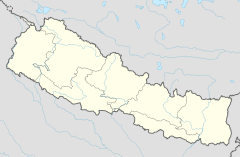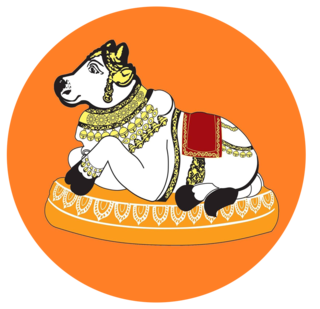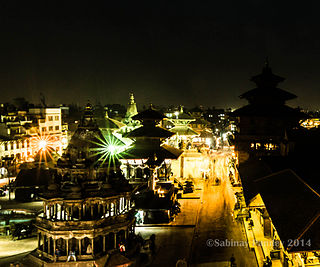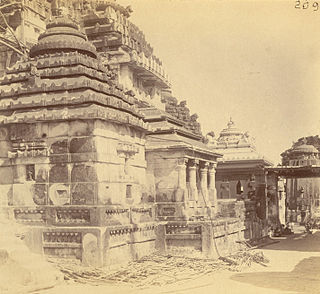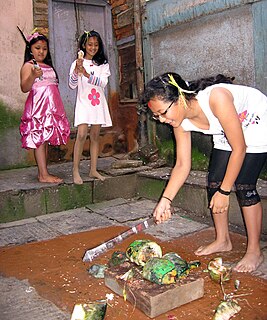| Nyatahpola (Nyatapola "ङातापोलँ") | |
|---|---|
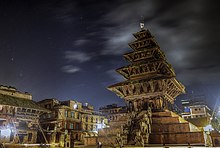 Nyatapola | |
| Religion | |
| Affiliation | Hinduism |
| District | Bhaktapur |
| Deity | Siddhi Lakshmi, Durga |
| Festivals | Dashain |
| Location | |
| Location | Bhaktapur, Taumadhi/Tahmhari ("तःम्हारी", तः=ठूलो + म्हारी=रोटी, means Large Bread) |
| Country | Nepal |
| Geographic coordinates | 27°40′17″N85°25′43″E / 27.67139°N 85.42861°E Coordinates: 27°40′17″N85°25′43″E / 27.67139°N 85.42861°E |
| Architecture | |
| Architectural type | Pagoda |
Nyatapola Temple is a 5-Roof (Nyata "ङाता" = 5 Storeys "तल्ला & Pola "पोलँ" = Roof "छाना"). Meaning is Five Storeys Roofed Temple. Pagoda Style temple located in Bhaktapur, Nepal. The temple was erected by Nepali King Bhupatindra Malla during a 7-month period from late 1702 to 1703. It is the temple of Siddhi Lakshmi, the Tantric Lakshmi who bestows auspiciousness. [1]

A pagoda is a tiered tower with multiple eaves, built in traditions originating as stupa in historic South Asia and further developed in East Asia with respect to those traditions, common to Nepal, China, Japan, Korea, Vietnam, Myanmar, India, Sri Lanka and other parts of Asia. Some pagodas are used as Taoist houses of worship. Most pagodas were built to have a religious function, most commonly Buddhist, and were often located in or near viharas. In some countries, the term may refer to other religious structures. In Vietnam and Cambodia, due to French translation, the English term pagoda is a more generic term referring to a place of worship, although pagoda is not an accurate word to describe a Buddhist vihara. The modern pagoda is an evolution of the stupa which originated in ancient India. Stupas are a tomb-like structure where sacred relics could be kept safe and venerated. The architectural structure of the stupa has spread across Asia, taking on many diverse forms as details specific to different regions are incorporated into the overall design. Many Philippine bell towers are highly influenced by pagodas through Chinese workers hired by the Spaniards.

Bhaktapur, literally translates to Place of devotees. Also known as Khwopa, it is an ancient Newa city in the east corner of the Kathmandu Valley, Nepal, about 8 miles (13 km) from the capital city, Kathmandu. It is located in and serves as the headquarters of Bhaktapur District in Province No. 3 of Nepal. It is administratively divided into 10 wards.
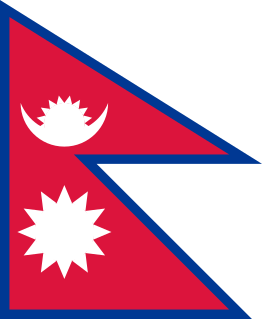
Nepal, officially the Federal Democratic Republic of Nepal, is a landlocked country in South Asia. It is located mainly in the Himalayas, but also includes parts of the Indo-Gangetic Plain. With an estimated population of 26.4 million, it is 48th largest country by population and 93rd largest country by area. It borders China in the north and India in the south, east, and west while Bangladesh is located within only 27 km (17 mi) of its southeastern tip and Bhutan is separated from it by the Indian state of Sikkim. Nepal has a diverse geography, including fertile plains, subalpine forested hills, and eight of the world's ten tallest mountains, including Mount Everest, the highest point on Earth. Kathmandu is the nation's capital and largest city. Nepal is a multiethnic nation with Nepali as the official language.
Contents
- Construction
- How it was built
- The Nyatapola Temple
- Religious figures and gods
- The Legend
- 2015 earthquake
- Historical Sources and records
- Gallery
- References

